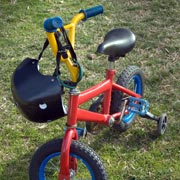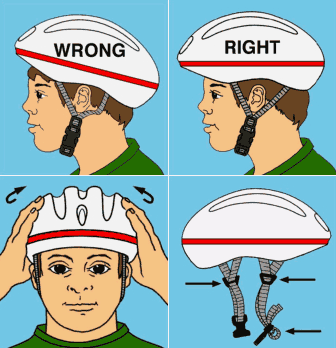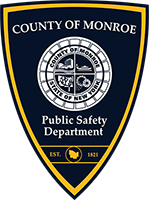For information on traffic safety programs, contact the Office of Traffic Safety at (585) 753-3130 or [email protected].
On This Page
- Educational Programs
- Bicycle Safety
- Seat Belt Safety
- School Bus Safety
- Railway Crossing Safety
- Teen-Driver Focused Program
- Quick Tips for Motorcycle Safety
- Displays
- Pedestrian Safety
- Do you know the correct way to wear a bike helmet?
- Traffic safety fairs
- Mature Driver Safety
Educational Programs
Roadway safety affects everyone in our community. Our programs cover various topics for pedestrians, cyclists, drivers, and passengers, while promoting responsible choices and caution. With presentations and events individually tailored to all ages and groups, different visuals and discussion help our team show why making the right choices can keep us safe.
Our team’s presentations and events may include statistical data, pertinent laws, real life examples, and/or hands-on activities to benefit all types of learners. We are always open to creating a custom program, as we have done many times before.
We also offer equipment to loan with agreed upon expectations and instruction.
Host expectations and location needs would be specific to each type of event or presentation. This can range from providing a single facilitator in a classroom, to organizing and providing multiple volunteers for a larger event.
Programming requests are filled on a first-come, first-served basis with considerations such as high crash rated areas, the capacity of our team, and the overall needs of our entire county. The scheduling document can be found here.
Bicycle Safety
For students: the goal of this program is to teach Monroe County students how to be safe bicycle riders, highlighting the importance of always wearing a bicycle helmet. Additional topics covered are: safe places to ride bicycles, basic bicycle maintenance (tires, brakes, chain, seat and handle bars), safety tips, and the rules of the road.
For adults: biking is becoming an increasingly popular mode of transportation. We can to make sure all adult riders are safe. Our team will review traffic safety laws, provide tips for finding the safest cycling routes in a rider's community, and share how to wear a properly fitted helmet on every ride.
Seat Belt Safety
For students: this program covers how to ride safely in a vehicle by emphasizing the importance of wearing a seat belt, and riding in the back seat for children under 12. Air bags are discussed and posters are used to show how to wear a seat belt properly.
For adults: this program encourages all occupants in the car to be strapped in tight, as seatbelts can be the only thing protecting against the forces of a crash.
School Bus Safety
This program covers all the essentials of school bus safety and a review of the rules relating to waiting for the bus, riding the bus, exiting the bus, and crossing the street after exiting.
Railway Crossing Safety
This program highlights how to be safe while crossing railways. Operation Lifesaver's curriculum provides presentations appropriate for each age range, from preschool to new drivers in drivers' education classes to adult drivers.
Teen Driver Focused Programs
Our team is excited to have meaningful conversations with community teens about best practices behind the wheel and as passengers. Through visuals, teen-focused videos, and hands-on activities, we hope all teens will walk away with a new perspective on why they can wait to answer text messages.
Quick Tips for Motorcycle Safety
Be visible:
- Remember that motorists often have trouble seeing motorcycles and reacting in time.
- Make sure your headlight works and is on day and night.
- Use reflective strips or decals on your clothing and on your motorcycle.
- Be aware of the blind spots cars and trucks have.
- Flash your brake light when you are slowing down and before stopping.
- If a motorist doesn’t see you, don’t be afraid to use your horn.
Dress for safety:
- Wear a quality helmet and eye protection.
- Wear bright clothing and a light-colored helmet.
- Wear leather or other thick, protective clothing.
- Choose long sleeves and pants, over-the-ankle boots, and gloves.
- Remember—the only thing between you and the road is your protective gear.
Apply effective mental strategies:
- Constantly search the road for changing conditions.
- Give yourself space and time to respond to other motorists’ actions.
- Give other motorists time and space to respond to you.
- Use lane positioning to be seen; ride in the part of a lane where you are most visible.
- Watch for turning vehicles.
- Signal your next move in advance.
- Avoid weaving between lanes.
- Pretend you’re invisible, and ride extra defensively.
- Don’t ride when you are tired or under the influence of alcohol or other drugs.
- Know and follow the rules of the road.
- Stick to the speed limit.
Know your bike and how to use it:
- Get formal training and take refresher courses.
- Call 1-800-446-9227 or visit www.msf-usa.org to locate the Motorcycle Safety Foundation hands-on Rider Course nearest you.
- Practice. Develop your riding techniques before going into heavy traffic. Know how to handle your bike in conditions such as wet or sandy roads, high winds, and uneven surfaces.
Please contact the Monroe County Office of Traffic Safety to schedule a presentation for your group or organization:
- Jean Triest (e-mail)
Phone: 585 753-3018
Displays
The Office of Traffic Safety offers comprehensive traffic safety displays for Monroe County: schools, senior citizen centers, neighborhood organizations, veterans groups, businesses, boy/girl scouts, community organizations, housing complexes, civic groups and special events/festivals.
Handouts are available concerning distracted driving; seat belt safety; air bags; child restraint seats; bicycle safety and helmet use; pedestrian safety; school bus safety; and other related traffic safety issues.
In addition, the “Vince and Larry, Crash Test Dummies” costumes are available for loan to Monroe County organizations wishing to promote seat belt safety.
NYS Governor’s Traffic Safety Commitee
Pedestrian Safety
The topic includes the concept of Stop, Look, and Listen and reviews the rules of pedestrian safety such as: using the safest route, crossing at street corners, obeying the walk-don’t walk signs, and stranger awareness. Parking lot safety and the concept of “visual screens” are also addressed with older students.
Do you know the correct way to wear a bike helmet?
Wear the helmet flat atop your head, NOT tilted back at an angle.
Make sure the helmet fits snugly and does not obstruct your field of vision.
Make sure the chin strap fits securely and the buckle stays fastened.

Traffic Safety Fairs
Our team offers highly interactive, family-friendly events in partnership with many organizations and schools. Get ready to pedal on our pedal kart course! Individuals can wear a pair of impaired driving goggles to experience potential cognitive and physical impairment while pedaling around a forty-foot circular course of orange cones. Various stations include practicing bike skills, mastering hand signals, practicing pedestrian safety skills, and more!
We also offer various traffic safety education stations for new drivers or students close to driving age. Topics can include impaired driving prevention, distracted driving prevention (we have a virtual simulator where an individual can grip a real steering wheel and stomp on actual pedals as they discover how distractions can be very dangerous), and more.
The Distract a Match game is one of our favorites, as all participants get to have fun! One person has thirty seconds to match puzzle pieces on a board, while simultaneously counting backwards from 100. Everyone around is encouraged to ask questions and create further distractions, thus emphasizing the importance of minimizing distractions when driving a vehicle.
While teens are aware of some of the tragic realities of unsafe choices in a car, painful experiences shared by those impacted directly can be a necessary reminder. Our Survivor Advocate Speakers offer poignant stories about family members who were taken from them far too soon at the hands of someone's unsafe driving choices.
Alcohol impairment / marijuana impairment goggle activities: wearing goggles to simulate the physical and cognitive impairment effects of alcohol and/or marijuana, individuals can experience how difficult it is to play catch, walk fowards and backwards in a straight line, complete a handwritten maze, and follow blinking lights in a grid mat activity.
Our impaired driving exhibit boards explore stories of impaired driving crash victims across New York State. The exhibits cover topics such as prescription drug impairment, motorcycle crashes, the story of Leandra's Law, and give real life connections to the tragic reality of this preventable crime.
Mature Driver Safety
As we age, our bodies change and positions within car cabins need to also be adjusted to allow for the safest drive. The proper fit inside your vehicle can make a big difference. Our team offers community events and 1:1 training, including CarFit and safe driving tips.














